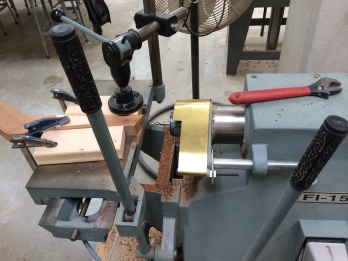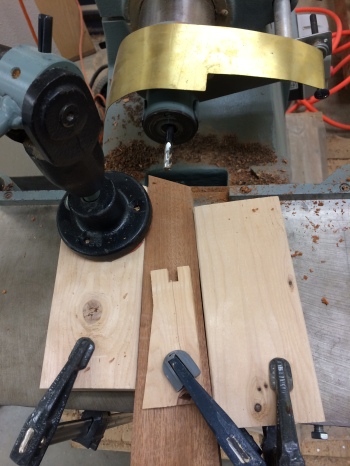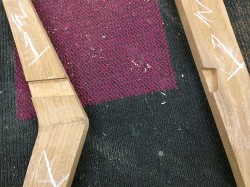I actually haven’t seen this movie, but I think I’m going to watch it tonight. A 1990 comedy/drama sounds like just the ticket. Phew! It has been a big few days! Good and bad things have happened. I cut the end of the armrests to match the angle of the front frame so they connect smoothly. I did this by angling the blade on the miter saw. Once the two chair parts lined up, I cut the joint, which is a floating tenon, so I had to cut mortises in both pieces that were being connected.
The School of Architecture has an incredible shop. I’m not sure I’ve mentioned that before. It is maintained by John Vehko, a former naval machinist turned educator. John is a cranky man with a big heart and an incredible mind for how to figure things out.  Often, I’ll know what I want an outcome to be, but just not be sure how to get there, and John tells me six different ways to do it after thinking about it for five seconds. It’s incredible. Anyway, the point of this digression is to say that the shop has a really cool horizontal mortiser, which makes life good. It allows you to set the height, depth, and width of your mortise really really easily. If you look at the photo above, the lever on the left slides the table from side to side to cut the width and the lever on the right slides the spinning bit in and out to cut the mortise to depth. I clamped boards on either side and on top of the frame piece to keep it in place and so the second piece gets cut at exactly the same angle. I first made a full-depth cut on one end of the mortise, then another full-depth cut on the other side. Then I made shallow passes in between the two holes to cut out the rest of it. I did it this way so the shavings and sawdust had somewhere to go, as opposed to tightening up inside the uncut mortise and burning from the friction.
Often, I’ll know what I want an outcome to be, but just not be sure how to get there, and John tells me six different ways to do it after thinking about it for five seconds. It’s incredible. Anyway, the point of this digression is to say that the shop has a really cool horizontal mortiser, which makes life good. It allows you to set the height, depth, and width of your mortise really really easily. If you look at the photo above, the lever on the left slides the table from side to side to cut the width and the lever on the right slides the spinning bit in and out to cut the mortise to depth. I clamped boards on either side and on top of the frame piece to keep it in place and so the second piece gets cut at exactly the same angle. I first made a full-depth cut on one end of the mortise, then another full-depth cut on the other side. Then I made shallow passes in between the two holes to cut out the rest of it. I did it this way so the shavings and sawdust had somewhere to go, as opposed to tightening up inside the uncut mortise and burning from the friction.
Then I repeated on the other frame piece, then I went through the same process on the armrests. With both mortises cut, I now had the size information I needed to cut the tenons, which I did on the planer and the table saw and then sanded the corners and trimmed down the length until they fit snugly and held together the frame and armrest!
 They close up flush, but I wanted you to see the “inner workings” (below).
They close up flush, but I wanted you to see the “inner workings” (below). 
Tenons don’t have to float; they can actually just be part of one of the boards, but I wanted to be able to test out the alignment of the pieces before I cut the joint and not having a tenon sticking out from one end from the get-go allowed me to do this.
With three sides of each frame complete (the fourth being the rockers), it was time to notch in the seat. The back connection is literally a notch where the back of the seat sits inside (below), and the front connection is more of a lap joint, where each of the two pieces sort of grabs the other one. To cut the back notch, I created a jig for the router. The jig is essentially a guide that only allows the router bit to go where I wanted it to, and stops the router from moving beyond the joint, essentially by clamping or screwing other boards in the way. The fence rides along the boards sitting on top of the chair frame and then there are additional boards on top of those that act as a barrier. The spinning bit cuts the notch and you move the router within the selected area to be cut by hand.
To cut the back notch, I created a jig for the router. The jig is essentially a guide that only allows the router bit to go where I wanted it to, and stops the router from moving beyond the joint, essentially by clamping or screwing other boards in the way. The fence rides along the boards sitting on top of the chair frame and then there are additional boards on top of those that act as a barrier. The spinning bit cuts the notch and you move the router within the selected area to be cut by hand.
Since the router bit is round and the notches are square, they have to be chiseled out afterwards to square the corners. There seems to be a lot of this incongruity in joinery: round cuts, square joints. The good thing is that you wind up cutting the joint a little too small with the router and then adjusting little by little until it’s the right size to fit the piece that goes into it. Too small is always better than too big. You can’t put material back.  Well, in some cases you can, but let’s not worry about that right now. In general, too small > too big.
Well, in some cases you can, but let’s not worry about that right now. In general, too small > too big.
Oh wait, did I say let’s not worry about that now? I think I jinxed myself by saying that. I wrote that yesterday and I should have known better, I mean been more superstitious. I repeated a similar process on the actual seat, where it will grab the legs–routing out a smaller chunk so I could chisel it to size afterwards–only I made the mistake of checking it against the leg/frame without the leg being connected to the armrest and back frame. As a result, the frame piece fits onto the seat, but now doesn’t fit perfectly into the armrest. I am mad. In hindsight, I should have glued up the frame first, and then cut the notches for the seat…in hindsight. So, now I’m left with a dilemma, do I slightly adjust the way the three frame pieces connect to one another or try to repair the joint that is off? Given that the frame pieces all fit together really well at this point, I’m inclined to try to repair the joint, but I will need a professional consultation before proceeding. I don’t meet with Mark until Tuesday, so I will get John’s opinion tomorrow and work on something else in the meantime. Stay tuned…










